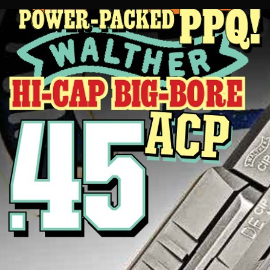In 1969 my employer had a Chevy pickup that I drove for work. Something about it didn’t feel right to me. I’d owned and driven an older Ford truck for years and the seating was just different. In the Chevy I always felt like I was sitting too far forward and leaning over the wheel and I never could find a seat adjustment that felt right to me. Chevy owners in that time frame probably would have had the same discomfort level driving a Ford.
What’s that got to do with guns, you ask? Hold on, I’ll get there, but I want to fast-forward this auto analogy a bit. I drive a Jeep Wrangler Unlimited. I love it! My wife drives a Denali SUV. She  loves it. I don’t like getting in her vehicle and she doesn’t like getting in mine. We don’t particularly enjoy driving each others’ vehicles, either. Why? The seating and mirror adjustments are off, the controls are different, the accelerators require a different touch – they’re just different. But they’re both excellent vehicles and they are up to the tasks we expect them to perform.
loves it. I don’t like getting in her vehicle and she doesn’t like getting in mine. We don’t particularly enjoy driving each others’ vehicles, either. Why? The seating and mirror adjustments are off, the controls are different, the accelerators require a different touch – they’re just different. But they’re both excellent vehicles and they are up to the tasks we expect them to perform.
Now to the guns. A few weeks ago I wrote about comfort while carrying a gun. Today I’m writing about comfort while shooting a gun.
In the past several weeks I’ve shot four different handguns to test their functionality with several types of ammunition, with the added goal of just staying in practice. The guns were a S&W M&P .40 ACP, a Sig Sauer P229 Legion 9mm, a .45 ACP Sig Sauer Commander-sized 1911 and a Glock 23 Gen 4. I was satisfied with how each of them handled the ammunition I fed it, which was a mix and match combination of Ruger ARX, Speer Gold Dot JHP and Fiocchi JHP. These are the rounds I primarily depend on for personal protection.
Results on the target were not much different from one gun to the next, with the exception of the Sig 1911. That particular SIG allows me to consistently put all the rounds I shoot into a small ragged hole, usually the size of a 50-cent piece from a distance of 10-12 feet. With each of the the other three I was successful in creating a tennis ball size ragged hole with some scattered rounds an inch or two outside that hole. Any one of those handguns would be “comforting” to have in a defensive situation.
But this article is about being comfortable, not just having something that is comforting. I’m always comfortable shooting that Sig 1911. The aiming is natural and consistent. I never even think about trigger pull, it just happens as I’m squeezing the trigger and I get the results I want almost every time. The sights line up naturally without me even thinking about it.
The M&P is the same way. I’ve always felt the S&W M&P was one of the most comfortable guns to hold and shoot. I keep one by the bedside and my wife has one on her side of the bed. I like it as a carry gun, especially now that I’ve learned I can shoot .40 caliber ARX ammo comfortably. If I wasn’t such a 1911 fan, the M&P would probably be my every day carry gun.
The other two guns give me pause when I’m shooting them, especially the Glock. There’s something about the Glock sights that just doesn’t work for me, especially on follow up shots, like when you’re doing a double-tap or a timed drill. It takes me a couple of seconds, to get those sights lined up and I’m always squinting or moving my head around to get the proper sight picture.
The sights on my Sig P229 Legion are very close to the Trijicon night sights I prefer on my carry guns but with an improvement that sets them apart. The dot on the front sight is a different color and is slightly larger than the rear sights, making it easier to pick up.
Here’s picture of the different types of sights I encountered during these shooting trips. Yes, I know the sights are not aligned for hitting the target, but this will work for illustration purposes.:

The SIG 1911 has sights almost exactly like the M&P in the center. Maybe, that’s a big part of the reason I feel like I shoot these guns better, the fact that the sights are familiar to me and I like them. But I don’t think that’s the biggest reason. I do struggle with the Glock sights, and I don’t struggle with any of the others, but I think the biggest reason might be grip. The M&P line has always enjoyed a following because it fits the hand so well and something about the angle of the grip and the alignment of the bore axis makes for less “felt” recoil than many other handguns of similar size, weight and caliber. I put “felt” in quotes because recoil is somewhat subjective. There are ways you can measure the foot-pounds of pressure being exerted on the hands, I guess, but what we shooters deal with is what we feel, not necessarily what’s actually there.
Between the Glock, the Sig and the M&P, the M&P just feels better in my hand, I line the sights up quicker and when I shoot it, I feel less recoil, all of which make for a better shooting experience as long as my rounds hit the target where I expect them to.
Between the Glock and the Sig, I like the Sig better. It’s got a better feeling trigger and the sights work well for me.
Among them all, however, I still pick the 1911 as the one I am the most comfortable shooting. Do you know what that translates into? I’ll choose to shoot it more often, which means I’ll practice with it more often and I’ll get better and better with it.
That’s why comfort is important.

 I’m all for selling guns. I’m in the business. And like any business owner, I’ve got rent to pay, suppliers to keep happy and employees I want to take care of. I can’t do all of that without selling guns, along with the ammunition, accessories and training to go along with them. But to me, it’s not about selling merchandise as much as it is about helping people. You see, deep down in my heart of hearts I believe people should be able to defend themselves. I believe they should be able to stand up against a tyrannical government, if it becomes necessary. And I believe people in a free country should be able to responsibly own guns because they’re cool, they’re fun to shoot and frankly, just because they want them.
I’m all for selling guns. I’m in the business. And like any business owner, I’ve got rent to pay, suppliers to keep happy and employees I want to take care of. I can’t do all of that without selling guns, along with the ammunition, accessories and training to go along with them. But to me, it’s not about selling merchandise as much as it is about helping people. You see, deep down in my heart of hearts I believe people should be able to defend themselves. I believe they should be able to stand up against a tyrannical government, if it becomes necessary. And I believe people in a free country should be able to responsibly own guns because they’re cool, they’re fun to shoot and frankly, just because they want them.
 I want you to think about something. What kind and size of guns do the police carry? What kind and size of guns to the LTC instructors you may know carry? You don’t find them carrying little guns. You don’t find them carrying small calibers. Or, if you do, I can almost guarantee you they are new to the business. Those of us who have really studied what goes on in the real world, those of us who have shot a lot of different guns, those of us who have studied real-world ballistics, rather than the fancy headlines in magazines and advertisements, are pretty careful about what guns we carry. Those of us who are instructors and who sell guns, have totally different perspective on what we recommend than does a typical gun salesman in a retail establishment.
I want you to think about something. What kind and size of guns do the police carry? What kind and size of guns to the LTC instructors you may know carry? You don’t find them carrying little guns. You don’t find them carrying small calibers. Or, if you do, I can almost guarantee you they are new to the business. Those of us who have really studied what goes on in the real world, those of us who have shot a lot of different guns, those of us who have studied real-world ballistics, rather than the fancy headlines in magazines and advertisements, are pretty careful about what guns we carry. Those of us who are instructors and who sell guns, have totally different perspective on what we recommend than does a typical gun salesman in a retail establishment.